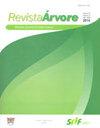云南紫金蛾的自然分布。在巴西目前和未来的气候情景由于全球气候变化
IF 0.8
4区 农林科学
Q4 FORESTRY
引用次数: 3
摘要
摘要:本文对乌氏霉属植物的分布进行了预测。是根据该物种的自然发生区域进行的。其地理坐标来自CRIA和specialllinks在线数据库,来自巴西圣保罗州Ilha Solteira的圣保罗州立大学(UNESP)的科学论文和实地调查。乌龙树是巴西一种具有巨大商业利用潜力的本土树种。为此,根据政府间气候变化专门委员会(AR4/IPCC)的第四次报告,利用巴西的Worldclim数据,使用生态位模型,包括当前的气候变量层和为未来气候情景准备的层。利用Open modeler和ArcGIS程序,根据对全球气候变化的预测,生成了预测其当前和未来气候情景的地图。随着该物种所在地区温度和降水的增加,它倾向于迁移到巴西目前气候较为温和的南部和东南部地区。由于气候变化,到2080年,该物种的分布和面积将发生变化。预估在两个时期,卡廷加和潘塔纳尔的面积都会增加,而塞拉多的面积在第一个时期会增加,而在第二个时期会减少。因此,根据未来几十年预测图的结果,得出的结论是,乌鲁德乌马的分布将发生变化,该区域的潜在发生面积将大大减少。本文章由计算机程序翻译,如有差异,请以英文原文为准。
NATURAL DISTRIBUTION OF Myracrodruon urundeuva FR. ALL. IN BRAZIL AT CURRENT AND FUTURE CLIMATE SCENARIOS DUE TO GLOBAL CLIMATE CHANGE
ABSTRACT In this work, the prediction of the distribution of M. urundeuva Fr. All. was performed based on the region of natural occurrence of the species. Its geographic coordinates were obtained from online databases CRIA and SpecialLinks, from scientific articles and fieldwork carried out by Universidade Estadual Paulista (UNESP) in Ilha Solteira, São Paulo, Brazil. M. urundeuva is a native tree species with great potential for commercial use in Brazil. For this purpose, ecological niche modeling was used, with current layers of climate variables and layers prepared for future climate scenarios, according to the 4th Report of the Intergovernmental Panel on Climate Change (AR4/IPCC), using Worldclim data on Brazil. With the Open Modeller and ArcGIS programs, maps were generated to predict its occurrence for the current period and future climate scenarios, made according to the projections of global climate changes. With the projection of increases in temperature and precipitation in the area where the species occurs, it tends to migrate to areas of Brazil where the climate is currently milder, in the south and southeast regions. Due to climatic changes, the species tends to undergo changes in distribution and area size until 2080. It was projected for Caatinga and Pantanal, in both periods, an increase in area, while for the Cerrado, in the first period, the area increased, and, for the second, it decreased. Therefore, according to the results of the maps of future projections for the next decades, it is concluded that there will be changes in the distribution of M. urundeuva, with a significant reduction of the potential area of occurrence in the region.
求助全文
通过发布文献求助,成功后即可免费获取论文全文。
去求助
来源期刊

Revista Arvore
FORESTRY-
CiteScore
1.00
自引率
0.00%
发文量
32
审稿时长
4-8 weeks
期刊介绍:
A Revista Árvore é um veículo de comunicação científica da Sociedade de Investigações Florestais – SIF. O jornal é de acesso gratuito, revisado por pares, que publica bimestralmente trabalhos científicos originais no campo da Ciência Florestal. As áreas temáticas para publicação são: Ambiência e Conservação da Natureza, Manejo Florestal, Silvicultura e Tecnologia da Madeira e Utilização de Produtos Florestais.
A política editorial visa manter alta conduta ética em relação à publicação e aos seus funcionários, rigor na qualidade dos artigos científicos, seleção de revisores qualificados, respeito profissional aos autores e processo de tomada de decisão imparcial. A Revista Árvore publica artigos apenas em inglês.
Artigos de revisão podem ser publicados se houver uma discussão relevante resumindo o estado da arte sobre o assunto. A revisão estrita da literatura não é aceita.
 求助内容:
求助内容: 应助结果提醒方式:
应助结果提醒方式:


